Important Notice
This site is no-longer being maintained, and the content and links found here may be irrelevant and outdated. It is online for archival purposes only.
I thought I would start compiling a list of commonly-used terms and acronyms in the pixel-lighting hobby, in hopes of helping others just starting out. I will add to and modify this as time goes on. This is an evolving hobby and some terms don’t necessarily have a clear definition. In these cases I will attempt to provide as many common opinions as possible.
This was last updated in September 2022.
If you feel I am wrong about something, or would like to see something else added or defined better- please let me know via social media…
or![]()
If you found this page through a search, please be sure to check out my Resources page as-well.
Table of Contents
- 1 Arch
- 2 Bullet Pixel
- 3 C9 (or C7)
- 4 Candy Cane
- 5 Cat. 5 (or Cat. 6)
- 6 Controller
- 7 Coro, Coroplast, Coro-Plast
- 8 Daisy-Chain
- 9 Differential Receiver
- 10 DMX, E1.31, DDP, Art-Net/sACN
- 11 Dumb (RGB, AC)
- 12 ESP, Node, MCU, NodeMCU
- 13 ESPixelStick
- 14 F-Amp, Pixel Amp, or Null Buffer
- 15 Firework
- 16 Flat Tree
- 17 FPP
- 18 Fuse, Circuit Breaker
- 19 Gauge (Wire)
- 20 GFCI, GFI
- 21 Master (Controller) or Show Runner
- 22 Matrix
- 23 Maxi (Mid) Tree
- 24 Mega Tree
- 25 Mesmerizer
- 26 Mini Tree
- 27 Null Pixel
- 28 P5, P10
- 29 PDU
- 30 Pebble/Seed Pixels
- 31 Pixel
- 32 Pixel Column
- 33 Pixel Pole
- 34 Pixel Stake, Peace Stake
- 35 Pixel Strip
- 36 Power Injection
- 37 PSU, Power Supply
- 38 RBL, RBB
- 39 Relay, SSR
- 40 Remote (Controller)
- 41 SBC (BB, BBB, RPi, PB)
- 42 SD
- 43 Sequence
- 44 Snow Flake
- 45 Smart (Differential) Receiver
- 46 Sparkle Ball, Sparkleball
- 47 Sparkledrop, Gumdrop
- 48 Sphere
- 49 Spinner
- 50 Square Pixel
- 51 Star
- 52 Starburst, Firework
- 53 Strip
- 54 Stand-Alone
- 55 Virtual Matrix
- 56 WLED
- 57 Wreath
- 58 WS2811
- 59 xLights
- 60 xScheduler
Arch
Popular pixel prop that arranges pixels in an arch shape. The pixels are often either mounted inside translucent plastic pipe/tubing or fastened to a wire frame. They are often called “jumping arches” because of the jumping light effects that are often applied to them. They can be of virtually any size- from just a few feet long and high to dozens of feet long and high. They are often mounted in the yard or on the roof, or extended over driveways and sidewalks.

Image Credit: https://lunardenlights.com
Bullet Pixel
This is the most commonly used format for RGB pixels. The are similar in format to mini-lights, but much larger- 12mm in diameter (approx. 1/2″).

C9 (or C7)
“Old School” Christmas light format. There were two primary forms of Christmas lights before “mini-lights” became popular back in the 1970s- C7 and C9 bulbs. These actually referred to the wattage of the bulb (C7=7w, C9=9w), but also refers to the size- C9 bulbs are larger than C7. Pixel enthusiasts either make or buy “C9” caps for standard bullet pixels, or buy “Pixa-Bulb” or similar versions pre-made. This is because a lot of people like the old-fashioned or classic look of these large bulbs.

Image Credit: 1000Bulbs.com
Candy Cane
This is a popular Pixel Pole like design, usually consisting of at least three columns of pixels in a classic candy cane shape. Often made of coro-plast, wood, metal, or other plastics. Some are even much higher density, providing a matrix-like canvas.

Photo Credit: boscoyostudio.com
Cat. 5 (or Cat. 6)
This refers to standard Ethernet networking cable. Cat. 5 (Category 5) refers to an older standard that generally supports up to 100Mbit (Mega-bit) Ethernet, while Cat. 6 is a newer standard that supports 1000Mbit, usually referred to as Gigabit Ethernet. Most Ethernet cable available to day is either Cat. 5e (an extension of the original Cat. 5 standard) and Cat. 6. The former is usually considerably cheaper and is more than adequate for use in this hobby.
Ethernet cable is used in 3 ways in this hobby. First- for networking, which is what it was originally designed for. Many controllers can be “hard wired” together into a network using commonly available Ethernet switches. Ethernet cable is also used for differential data between a controller and a differential receiver. In both of these cases- standard “RJ45” connectors are installed on each end of the cable using specific connection standards. Ethernet cable can also be used for pixel (WS2811) data, and can provide much longer distances than “straight” LED cable extension options.
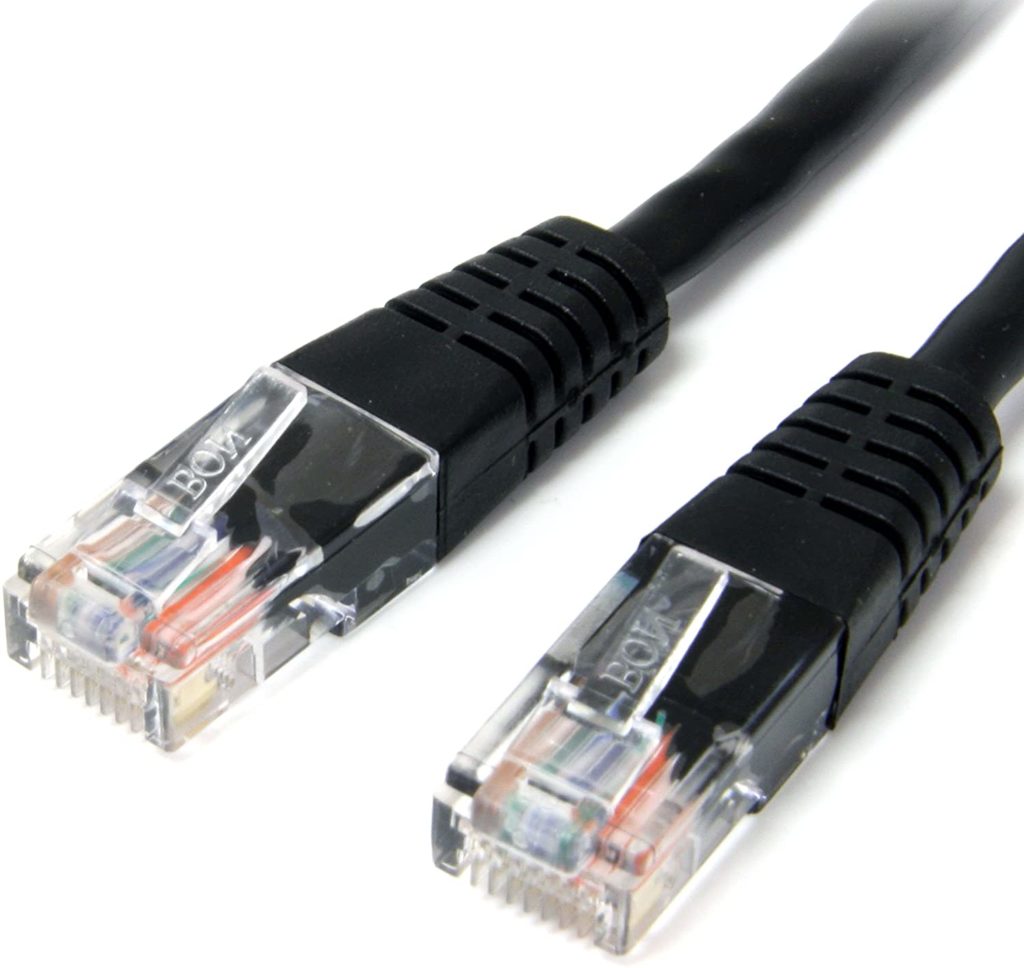
Controller
A controller sends pixel, and optionally differential, data to control pixels. The most commonly used protocol for doing this is called WS2811. Most pixels either have WS2811 chips in them, or have compatible chips that understand WS2811 signaling. Some controllers use on-board CPUs and can be sent data directly from a “player” computer, or can run a display using data stored on an SD card. Others have a built-in player computer and can run a display by themselves, or accept control from a player computer.
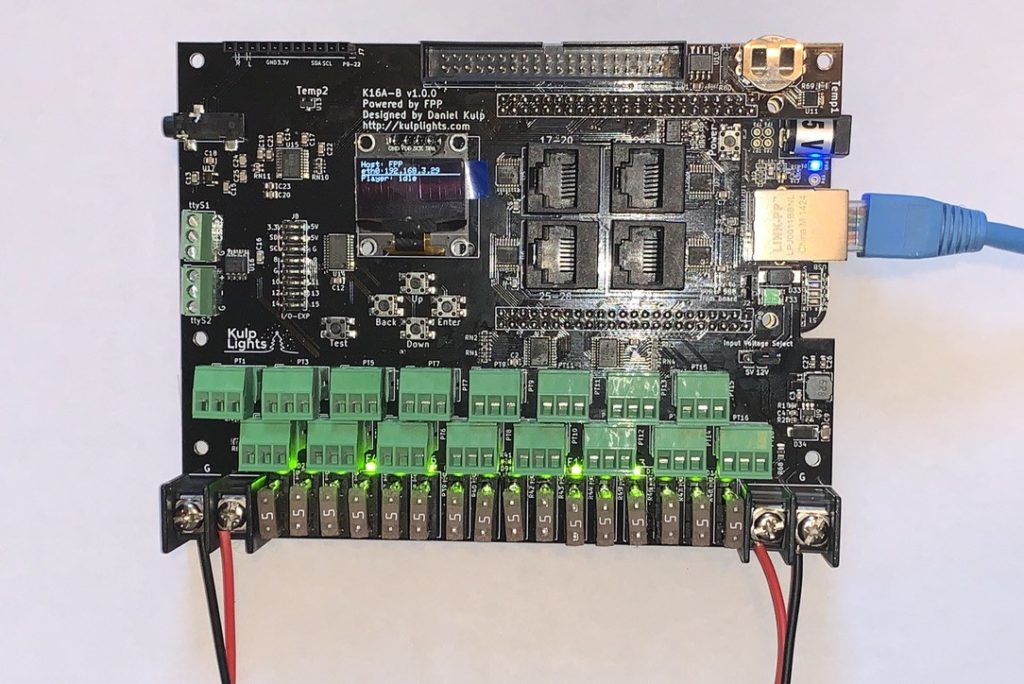
Image Credit: https://kulplights.com
Coro, Coroplast, Coro-Plast
Corrugated plastic, similar in construction to corrugated cardboard. It is commonly used for signs, displays, hobby construction, and kiosks. This versatile material has become a very popular medium for holiday decorating, and especially pixel props. It is available in various thicknesses and corrugation densities. It can be cut using common hand and power tools, but is most often cut using CNC machines.

Daisy-Chain
In this hobby, and in electronics in-general, daisy-chaining refers to the practice or ability to connect circuits end-to-end. So- the output of one circuit connects to the input of the next, and so-on. In electronic terms- it refers to components running in “series”. A pixel string itself is a daisy-chain of WS2811 pixel modules- each one connects to the next, and the data output of one feeds the data input of the next. Similarly props and other pixel elements can be daisy-chained together, sometimes with F-Amps (Pixel Amps) or Null Pixels, as a means to reduce port usage on a controller or reduce data cabling needs. For example- 10 props with 50 pixels each could be run from 10 controller channels, or if they are close enough to each other- they could be daisy-chained together to only use one controller port.
Differential Receiver
Pixel controllers generally have two different kinds of outputs- “Pixel” and “Differential”. Pixel data can only travel short distances by itself without being amplified. Differential data uses RS-485 and similar serial data communication standards to transmit data over larger distances, often as much as 300ft or more. This data needs a receiver to convert it back into pixel data, which is what a Differential Receiver does. Four channels of data are sent over regular “Cat. 5” or “Cat. 6” Ethernet cable. Differential Receivers can drive four strands of pixels from those four channels. The number of pixels depends on the controller. Because the data connection does not include power- Differential Receivers also usually have Power Distribution functionality built-in. They are often located in a weatherproof box with one or more PSUs (Power Supplies). There are several kinds of “smart” differential receivers that are available that can be daisy-chained together. Most controllers can drive regular “dumb” receivers, and generic ones are widely available. Most “smart” receivers are controller/brand specific.

Image Credit: Hanson Electronics
DMX, E1.31, DDP, Art-Net/sACN
These are all lighting control protocols, with DMX and sACN (also called Art-Net) originating in the theatrical/concert lighting world. DMX is actually a shortened form of “DMX512” and was developed in the mid-80s for professional lighting applications. Later Art-Net/sACN was developed as “DMX over Ethernet”. E1.31 was later developed as a more efficient DMX/sACN data streaming protocol, that can work over WIFI. Up until recently, E1.31 was the most commonly-used protocol for communicating between show-runners/players and controllers. DDP (Distributed Display Protocol) is a newer streaming standard loosely based on E1.31 that is now the preferred protocol for communicating lighting data. It eliminates a lot of packet overhead/waste that exists in the older standards.
Dumb (RGB, AC)
General term referring to non-pixel lights, where individual lights cannot be set to a specific color (addressed) using a controller. This can refer to classic Christmas bulbs and mini-lights, or to LED lights that can change colors, but cannot be individually addressed. There are “AC” and “RGB” controllers that can flash these lights or change the color of an entire string, which can be used for decorating, but these have largely been replaced with pixels.
ESP, Node, MCU, NodeMCU
Okay, this is confusing, and I admit I have jumbled these words and acronyms together in various ways, which actually all “work”. First- ESP actually stands for Electronic Signal Processor, but we aren’t actually using those. In this case- it is an abbreviation for a company, Espressif, a Chinese manufacturer of MCU (Micro Controller Unit) chips. These are boards with “SOCs” (System On (a) Chip) which consist of a processor, memory, storage, WiFi radios, and multiple input and output circuits (GPIOs). NodeMCU refers to hobby development boards based on these chips, which are manufactured by many different Chinese companies. The dev-boards, as they are called, add additional memory, power management, Reset button, status LED(s), and usually a MicroUSB port for power and programming. They are frequently used as controllers in automation and robotic systems.
So- to try to make an already-long story short- any of these refers to a tiny microcontroller (MCU) board. Why does this matter for our hobby? Special firmware can be loaded onto these little circuit boards, turning them into tiny WIFI pixel controllers! For more information, see ESPixelStick below, and WLED later on this page.



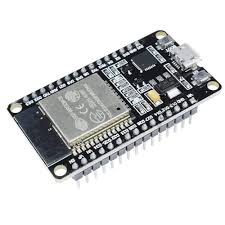
ESPixelStick
ESPixelStick refers to either hardware or the firmware developed for it. An ESPixelStick is a tiny pixel controller developed by Shelby Merrick, based on the ESP8266 (above). It can drive a single string of pixels using E1.31 (and now DDP) signaling from a show-runner or other controller. The newest version has a Micro-SD slot and is being developed as an FPP Remote device. Because the ESPixelStick firmware is open-source and will run on almost any ESP NodeMCU (see above), many also simply buy development boards, solder together a few components, and load the firmware to build their own “PixelSticks”. I started my pixel hobby using these homemade PixelSticks, usually just referred to as “nodes” or “NodeMCUs”. 🙂
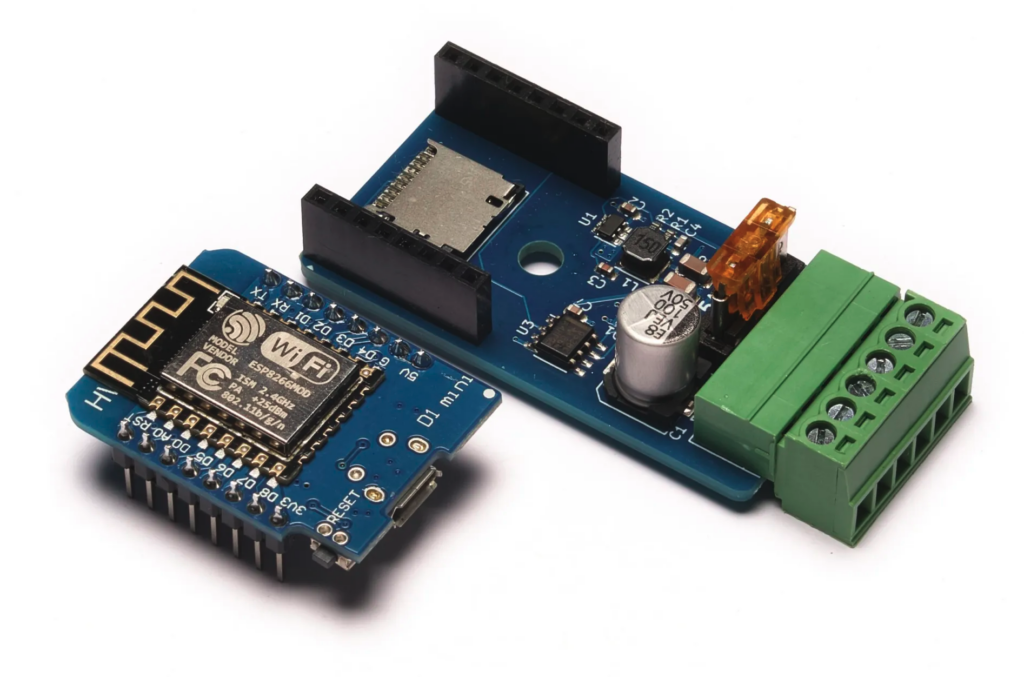
F-Amp, Pixel Amp, or Null Buffer
F-Amp is Falcon’s version of a pixel amp or null buffer, but like Kleenex it has become a generic term to refer to pixel amps. A pixel amp is a small weatherproof circuit, often in the similar casing as a square pixel, that is used to amplify a pixel signal between two props. When daisy-chaining props- pixel data can generally only travel about 15′ between pixels (this is a rule of thumb and varies wildly). A Pixel Amp every 15-20′ insures the data will get to the next pixel. These often replace “Null Pixels”, and unlike null pixels do not need to be accounted for in display design as they don’t consume data while amplifying the digital signal.
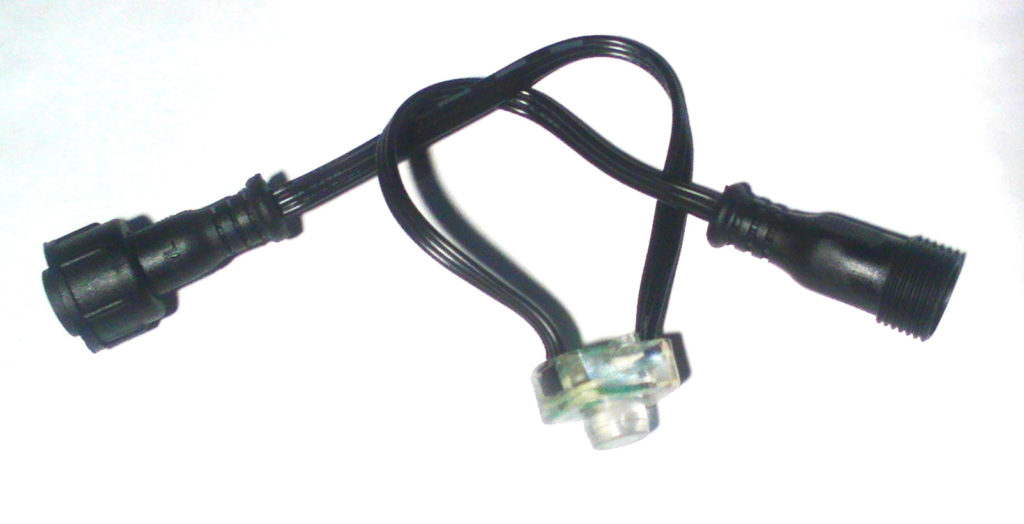
Image Credit: http://www.hansonelectronics.com.au
Firework
See Starburst
Flat Tree
This can be “mega tree” size, but consists of pixel strips either mounted to a wall, or hanging down from a wall, in a tree-like shape. A flat tree can have a pixel density that supports matrix-like displays, similar to a mega tree (defined below), but is generally not rounded, and is not free-standing like a mega tree.

Image Credit: https://lunardenlights.com
FPP
FPP, originally Falcon Pi Player, is show-runner/player software that runs on SBCs (Single Board Computers) such as the Raspberry Pi and BeagleBone. It stores sequence and media files that can be assembled into playlists, which can then be scheduled to run at specific times/dates. It sends DMX, E1.31, or DDP data to controllers to “play” lighting effects based on the sequence, and provides audio and/or video output for those sequences. It is also integrated into some controllers, such as Kulp’s, providing full controller management capabilities as-well. It is currently the preferred method of running pixel-based shows.
https://github.com/FalconChristmas/fpp/releases
Fuse, Circuit Breaker
A fuse, or in some cases Circuit Breaker, is an electrical component that disconnects power to a shorted or overloaded circuit. It is very important to insure that all of your wiring and props are protected by properly installed and rated fuses.
Gauge (Wire)
Most commonly refers to American Wire Gage (AWG), which refers to the thickness of wire. Wire is manufactured by stretching a metal bar through multiple progressively smaller dies until it reaches its final size. Wire Gauge was originally based on the number of these dies- so the larger the number, the SMALLER the wire is.
Most pixels use very thin wires- anywhere between 18-24AWG, or at least that’s what the manufacturers claim. Often the wires in pixels are significantly thinner than advertised. DC electricity really needs thicker (lower gauge) wire, as DC voltage is quickly lost to resistance, and thinner wires have more resistance over a distance. Most recommend 12-14 gauge wire for longer power runs, but you can generally use 14-16 gauge for shorter runs. 18 AWG is a minimum for short power injection runs incorporated into or between closely-placed props.
GFCI, GFI
A Ground Fault Circuit Interruptor, usually just called a GFCI or GFI, is an electronic device that very-very quickly disconnects power if it detects an abnormality in the current consumed by an attached load. In short- it helps prevents someone or something (like a pet or wild animal) from being electrocuted by detecting current flowing to the ground. GFCIs are required by most electrical codes for all outdoor outlets and those in close proximity to sinks, bathtubs, showers, etc. In many cases they are also required for basement outlets which could be exposed to flooding. GFCIs can be incorporated into electrical outlets or circuit breakers.
For your safety and the safety of those watching your show- always use GFCI protected outlets or circuit breakers for the outdoor components of your show. If you are unable to install GFCI outlets or breakers, consider in-line GFCIs like the following:
(Affiliate Link)
Master (Controller) or Show Runner
A “Master” or (more P.C.) Show Runner controller is the primary controller (usually running FPP) that runs a light show. The Show Runner holds the playlists and scheduler, and sends synchronization data to any secondary/remote controllers to keep everything running together via a WIFI and/or wired network. The Show Runner may or may not run pixels itself- it may just be used for audio or to manage the other controllers.
Matrix
An arrangement of pixels in a grid pattern that can be used to display complex light patterns, graphics, and text. Matrixes can be almost any size and density. Some use 1″ or smaller spacing and are suitable for closer view. Others are use up to 3″ spacing and are better viewed at long distances. They do not necessarily have to be rectangular, such as in the case of a matrix-capable Mega Tree or Spinner.
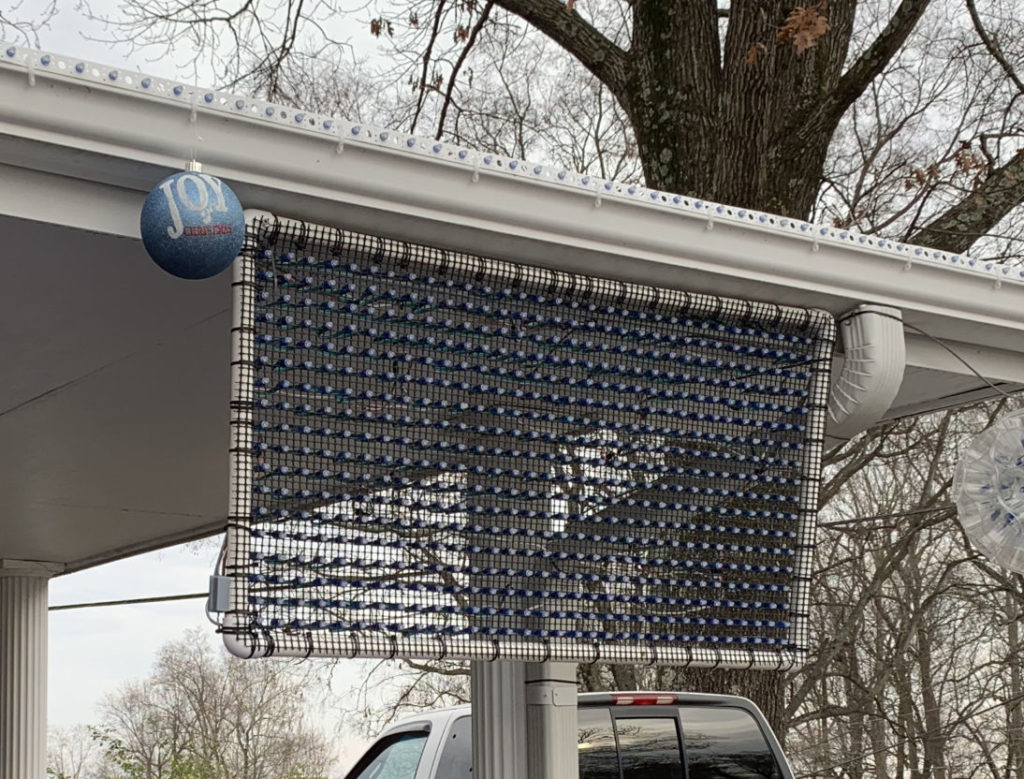
Image Credit: https://lunardenlights.com
Maxi (Mid) Tree
This is a term I’m using for our own show that will hopefully catch on, otherwise- you will at least see it referenced here! 🙂
A Maxi Tree is a high-density pixel tree similar to a Mega Tree, but 10′ or less in height. It’s capable of displaying “Mega Tree” graphics, just in a smaller package that arguably may not be called a “Mega Tree”. This is a step between a “Mini” tree and a Mega Tree (below).
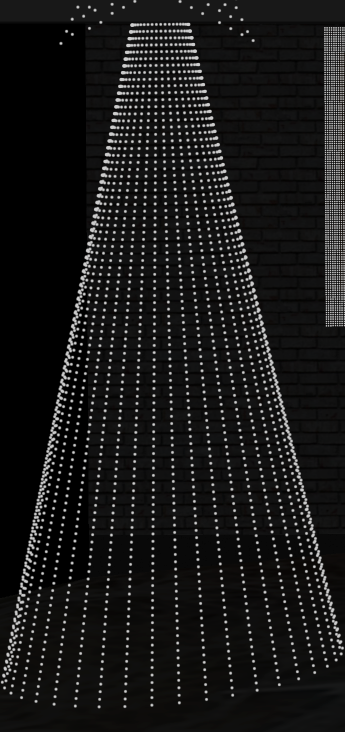
Maxi Tree
Mega Tree
This is a large Christmas tree-shaped assembly of pixels. There is a lot of debate in the community about what constitutes a “Mega” tree. Some insist it has to have a certain density of pixels and be as tall as 20′ feet or more or it isn’t “Mega”. Some say it must be free-standing or it isn’t a “Tree”.
My own definition, which echos many I’ve seen online, is: A Mega Tree needs to be at least 10′ tall and have enough pixel density to display discernible graphics. It should be a free-standing conical shape reminiscent of a classic Christmas Tree.
Some prefer a 360 degree tree for authenticity or for “walk-through” displays, but most make trees with a 180-240 degree viewing area to conserve pixels.

Image credit: magicchristmas.org
Mesmerizer
Newer term for a large and extremely high-density spinner. These are essentially round matrixes capable of displaying very complex patterns, graphics, and in some cases text.

Photo Credit: boscoyostudio.com
Mini Tree
This is a smaller pixel tree, generally under 5′ tall with fewer strands than a Maxi or Mega Tree. These are usually capable of displaying simple patterns and showing “movement” in lights, although some higher-density configurations can display matrix-like content. Some are constructed similarly to Mega Trees- using some kind of topper and round base, but there are also coro versions available. Some construct them from tomato cages.
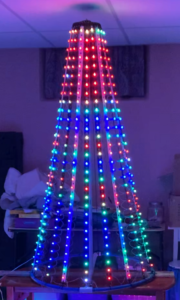
Null Pixel
This is simply a pixel that is not used as part of the display. More specifically- it often refers to a pixel that is being used just to increase the transmission distance between other pixels while daisy-chaining props or other display elements. Normally pixel data can only travel around 15′ reliably between pixels. (This is just a rule of thumb, and varies wildly.) For runs longer than that- one or more Null Pixels can be used to help bridge the distance. Null pixels need to be accounted for in show design- as they still consume data, and generally need to be set to remain dark. They can be coated or covered too, but will still be accounted for in the pixel count. These have largely been replaced with F-Amps (Pixel Amps).
In some cases, and in simpler terms, Null Pixels are simply pixels that we don’t want to light up. These are often found in props where a pixel needs to be skipped because of too short of a wire, or extra pixels at the beginning or end of a string that one doesn’t want to cut off. Null Pixels can be added to xLights or other sequencer models so they remain dark.
P5, P10
This is a modular pixel matrix, used to construct larger matrixes. These are slightly larger than 12″ x 6″ modules consisting of a matrix of tiny LED pixels. They are designed to be mounted to to each other to present a “seamless” display. The number refers to the “pitch” between the pixels. A P5 has pixels on 5mm centers, while a P10 uses 10mm centers. These modules are commonly used in the “real world” for HD scoreboards, billboards, promotional and directional displays. Many prefer to use them as alternatives to pixel matrixes or virtual matrixes. Just one can be used for small scrolling text displays, but otherwise the can be connected like building blocks into rectangular displays of varying shapes and almost unlimited size. They require special controllers and cabling, as well as connectors and housings.
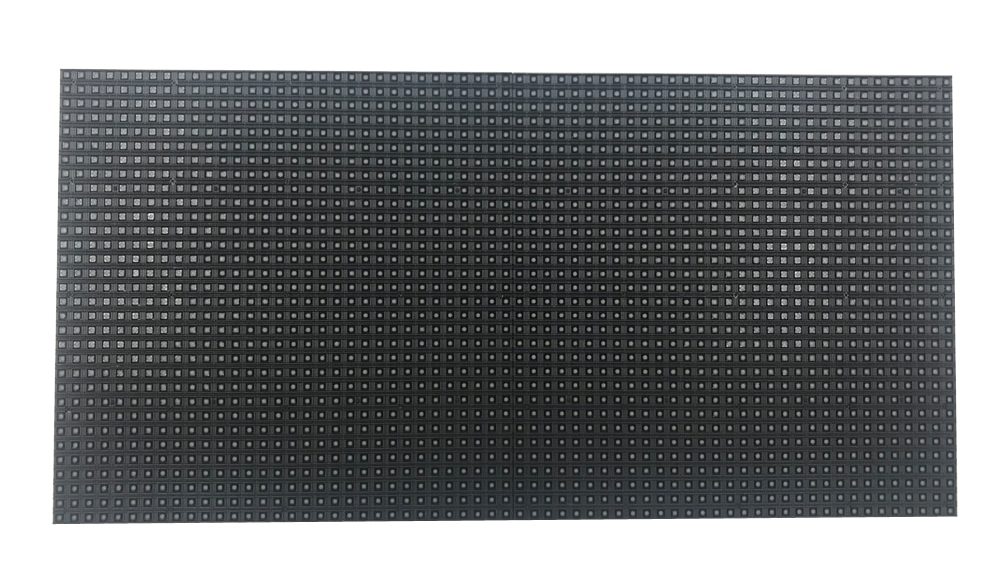
PDU
Power Distribution Unit (Board or Block). An “old-school” analogy would be a fuse box/block. This is a circuit board or assembly that provides fused outputs from a larger PSU (Power Supply) source. Generally you will have more power lines running to pixels and controllers than there are terminal for on a PSU. Most PSUs are internally fused and provide 10 or more Amps of power, while individual pixel circuits require fused protection in the 5-7A range. Because of this, some form power distribution is required for safe operation. You can, of course, just use a bunch of fuse holders and several electrical junctions to do this, but a safer way is to use a PDU. Some just use automotive/marine fuse blocks, while others use specialty boards specifically for the hobby.

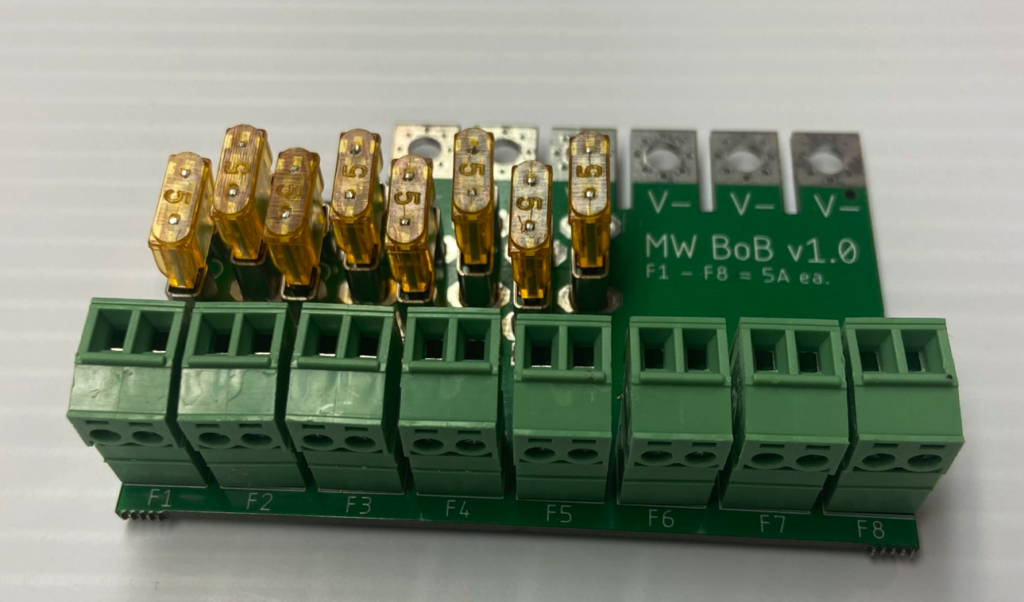
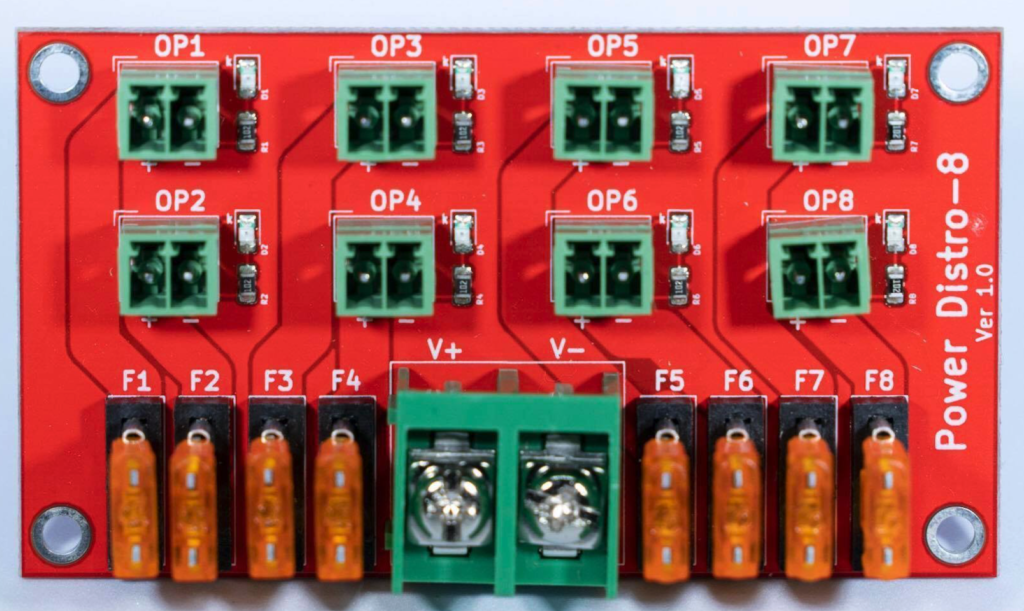
Pebble/Seed Pixels
While they have been around for awhile in more conventional decorating, these became a popular show option in 2023 with wider availability of WS2811 versions. They are small LED pixels encased in epoxy with wires going directly between each one. There is no base like a square or bullet pixel. They are very stylish and sleek, and can be used in many applications as alternatives to the much bulkier conventional pixels. They are perfect for arches and outlines, for example, and some are even using them for smaller trees, since they don’t need pixel strips.
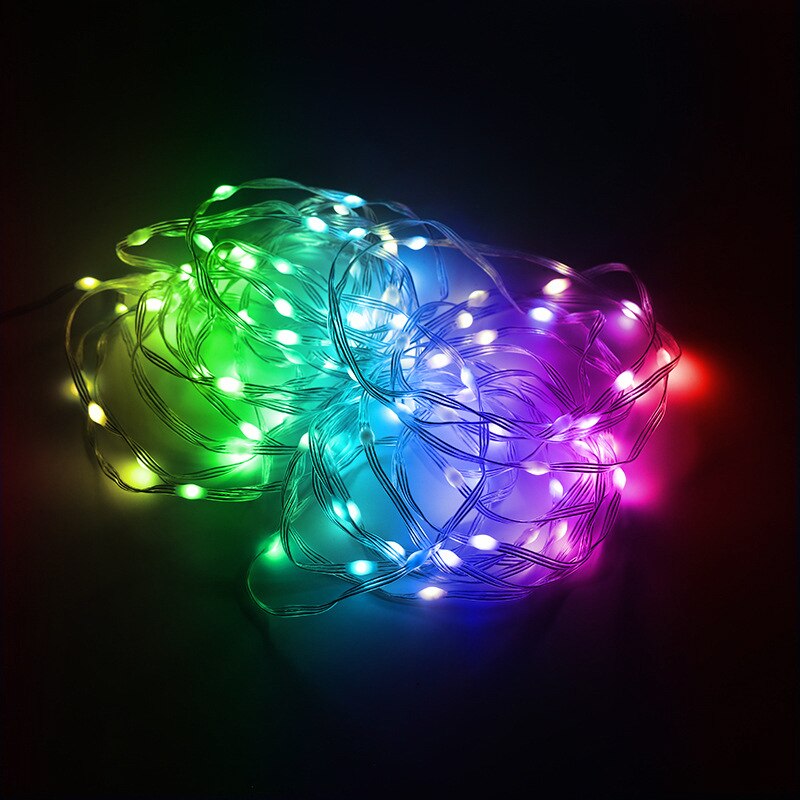
Pixel
An LED module capable of displaying a wide variety (theoretically millions) of colors using internal red, green, and blue (RGB) LEDs. These modules come in a variety of different shapes and sizes. 12mm diameter WS2811 pixel modules are primarily used in this hobby.
The key defining factors are each module, or “node”, must be:
- Individually addressable.
- Able to display thousands of colors.
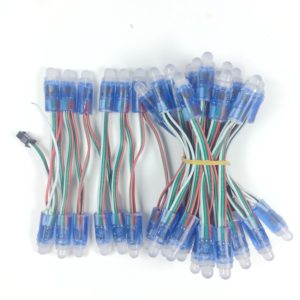
Pixel Column
A column of pixels, usually attached to a physical column. Generally consisting of 3 or more rows of pixels. Some are high density, using P10 or P5 matrix components, creating a tall-thin high-definition matrix.
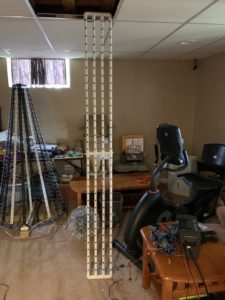
Image Credit: https://lunardenlights.com
Pixel Pole
These can vary anywhere from a longer single-column Pixel Stake to 3-4 columns of pixels. They are generally 3-4′ in height, although there are no limits. They are generally too narrow to provide matrix capabilities, but can display complex patterns that accentuate other elements in a display. Think of these as somewhere between a Column and a Stake.
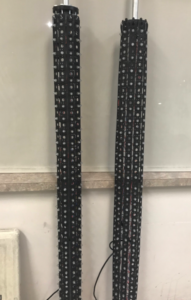
Image Credit: http://facebook.com/NelsonFamilyLights
Pixel Stake, Peace Stake
Originally called Peace Stakes for their use in the Peace Family Light Show, where they were first debuted to a wider audience, these are now more-commonly just called Stakes or Pixel Stakes. A small stake usually consisting of 3-5 pixels spaced 1-2 inches apart. The ones we build consist of 5 pixels about 1.5″ apart, although there are many-many variations and styles. Usually these are used in large quantities as pixel “ground-covers” which can accentuate other yard props. In advanced configurations and large enough numbers- they can product matrix-like effects, or make it appear that the yard is “moving”. They are very-very versatile.
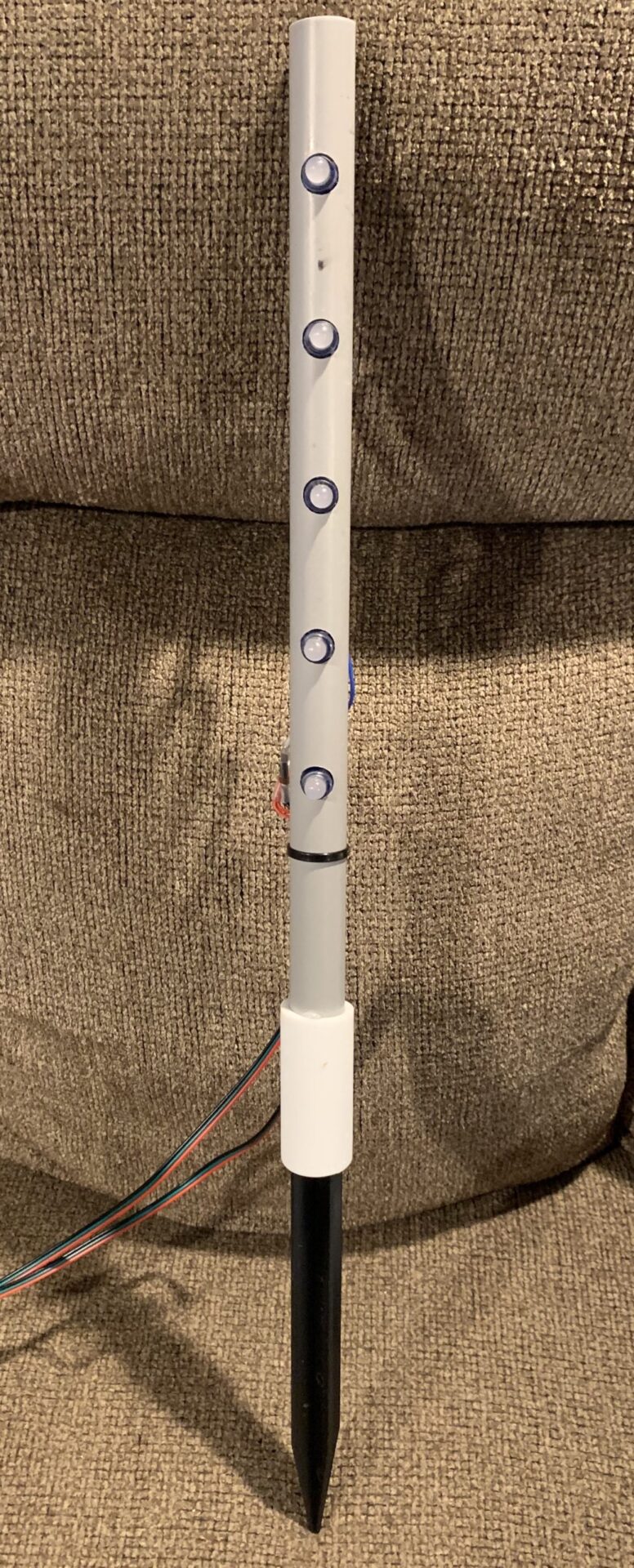
Image Credit: https://lunardenlights.com
Pixel Strip
Generally these are plastic strips with holes cut in them for pixels at fixed distances, usually 1″, 1.5″, 2″, or 3″. These can be used to build pixel trees, matrixes, house outlines, roof outlines, and anything else that requires pixels to be held at specific distances from each other in a straight line.

Photo Credit: boscoyostudio.com
Power Injection
Pixels are powered by DC current. As any electrical current passes through a wire- it slowly loses voltage. For reasons beyond the scope of this definition- this is much more of a factor with DC current. The size of the wire (gauge) effects this as well- the smaller the wire, the faster the voltage will be reduced. Pixels unfortunately tend to have very-thin wires between them. This “voltage drop” means that after a certain distance- there is no longer enough voltage for the pixel to operate, either at all, or at a desired brightness and color accuracy. Pixels not provided with enough voltage tend to dim and not display all of their colors correctly first. Even lower voltages result in data failure (random flashes/strobes), and eventually pixels not lighting at all. Because of this- it is necessary to “inject” power at intervals along a string of pixels. There are whole articles written about power injection, and different techniques.
My rule of thumb is:
5v pixels need injection every 100 pixels (so no pixel is more than 50 away from a power source).
12v pixels need injection every 200 (so no pixel is more than 100 away from a power source).
Lots of people will be happy to tell you they get away with a lot more than that, but this works for the majority and gives you easy numbers for design planning.
PSU, Power Supply
Power Supply Unit, or just Power Supply. Provides power for pixels and controllers, and associated equipment. Pixels, while very-very efficient compared to “old school” Christmas lights, still need a lot of DC power. You can’t run them off a simple plug-in power supply- you need (several) industrial-grade power supplies to provide either 5v or 12v for the pixels, depending on the kind you choose to use. There are “weatherproof” PSUs primarily used for outdoor signage, but most use indoor-rated “metal frame” PSUs, and put them in weatherproof boxes/enclosures. The most popular PSUs in this hobby are the Mean Well LRS-350 range, although similar generic ones are widely available and much cheaper. I personally recommend Mean Well as I have used them in other projects and they have proven to be very-very reliable.
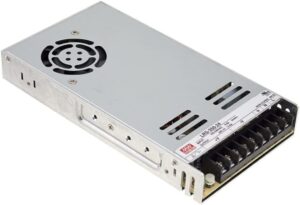
RBL, RBB
Really Big Light (Bulb). This is a large hollow plastic representation of a (C9) Christmas light bulb. Usually these are at least 8″ in diameter. Clear and frosted versions can often be had at Home Depot and similar home centers. They come with cheap battery-operated or plug-in lights that folks replace with pixels.

Relay, SSR
A Relay, or Solid State Relay (SSR), is an electronic component that allows a lower or dissimilar control voltage to switch a much higher voltage or current. A mechanical relay uses an electromagnetic coil to manipulate one or more contactors to switch electrical current. These make a clicking noise when operated. An SSR uses an electronic circuit to switch electrical current, but does so silently. Special isolated relays or SSRs are often used with SBCs (see below) or micro-controllers to control power to pixels, “dumb” lights or mechanical props. For example- a 3.3v control voltage from a Raspberry Pi and an appropriately rated SSR can turn a 120v prop on and off.
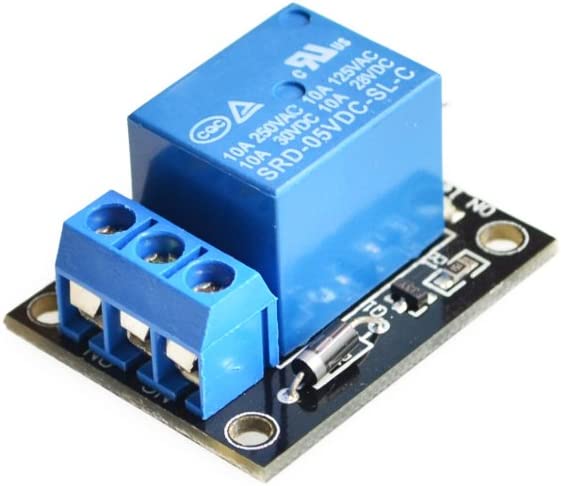
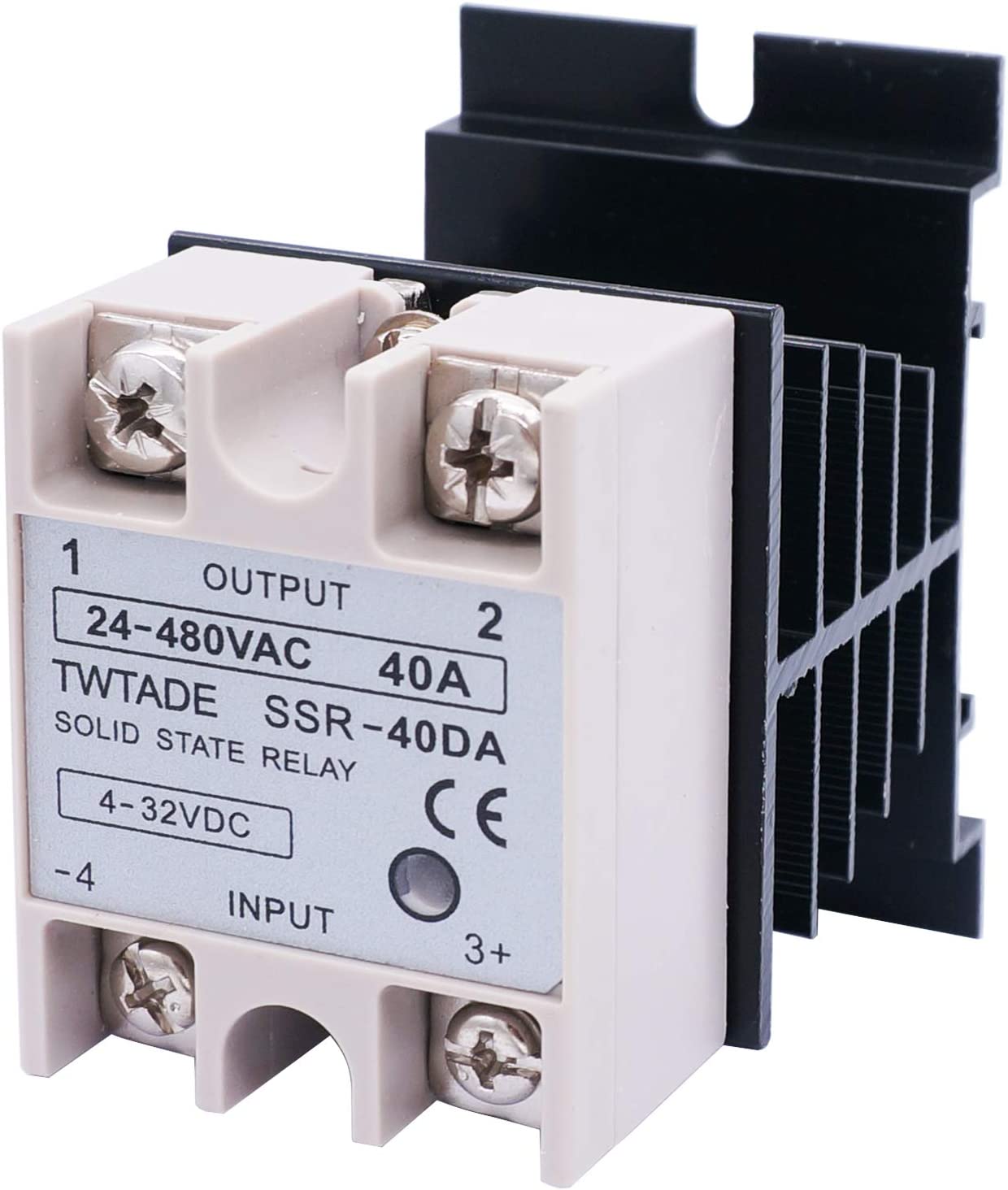
Remote (Controller)
This is a controller that runs a specific set of pixels or other components (such as audio or video) as directed by a Show Runner (Master) controller. It generally cannot run a light show by itself, and usually only has the sequence data it needs to run its part of the display, and not any media or other data. This would normally be an SBC (below) running FPP in “Remote” mode. The Show Runner sends the Remote the sequence name to run, along with time synchronization packets.
SBC (BB, BBB, RPi, PB)
Single Board Computer. These are small fully-functional computers that usually run a version of the Linux operating system. The most-commonly used SBCs are:
- Raspberry PI (RPi)
- Beagle Bone Green (BB)
- Beagle Bone Black (BBB)
- Pocket Beagle (Bone) (PB)
SBCs are made specifically for hobby electronics and computer education, and one of their key features is a GPIO BUS– all those pins/connectors on the edge of the boards. Those pins can control devices through serial communication or analog logic, and most can either read (listen for) or write (send) data. More often than not- you will use an SBC with a “hat” or “cape”, which is another board designed to interface to the SBC using the GPIO header(s). Many pixel and P5/P10 panel controllers are designed as “hats” or “capes” for either a Raspberry Pi or Beagle.
In most cases, you don’t need to know much more about them, other than that you may need to “burn” or save a software package to an SD card, and plug it into the SBC. The SD card serves as the “disk” the computer runs on. They are usually then managed using a Web browser, with no need to learn the intricacies of the operating system.
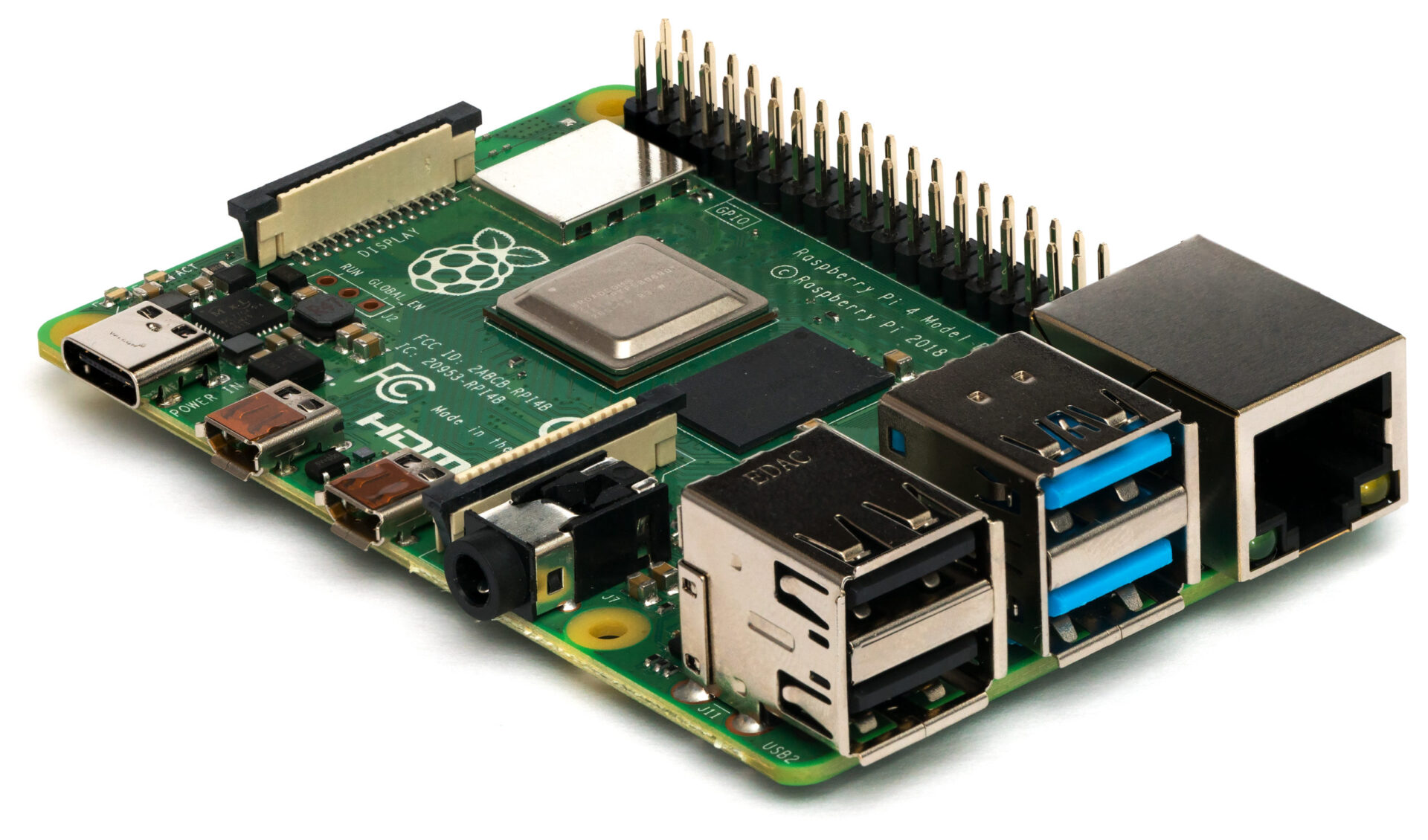

SD
Usually actually refers to Micro-SD. This is a small form-factor digital storage device, previously used primarily in cameras and digital media players. It resembles a plastic chip with some conductor strips on one end. The Micro-SD, as the name implies, is a tiny form factor of the older “SD” card. It’s about the size of a thumbnail and comes in storage sizes commonly ranging from 4GB up to 256GB and larger. Generally Micro-SD cards (or “chips”) between 8-32GB are used for pixel controllers and SBCs. They perform the same function as a “hard disk” or SSD does in a laptop- providing digital storage for the firmware and operating system, program files, and data/media files. Larger sizes are needed to store large numbers of audio, graphics, and video files.
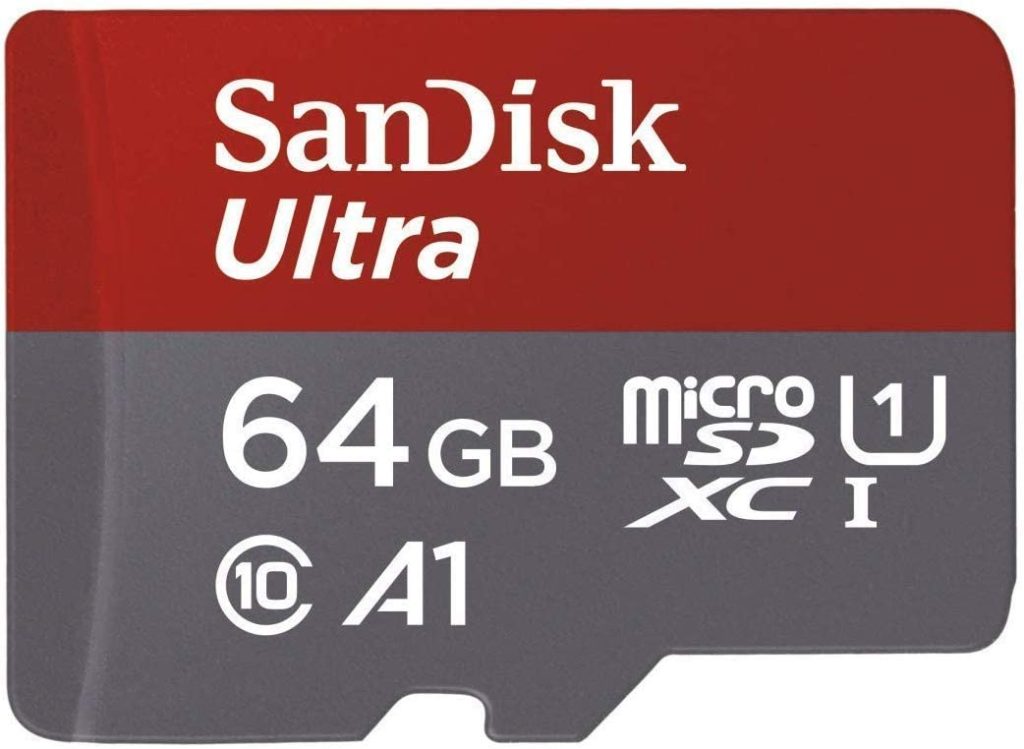
Sequence
The verb form is the process of generating display parameters for a pixel light show. This uses computer software to map various patterns, text, and other effects onto one or more (or all) elements of a pixel display. Often this is done to synchronize the display to an audio or video track. The most common software used for this is xLights. The software generates a controller-specific data file, also called a Sequence (File) that can then be used by the pixel controller to light/flash individual pixels to the colors specified according to a specific timetable based on the source audio or video, or pattern specifications.
The noun is the sequence itself, which consists of one or more computer files, often packaged into a Zip file for distribution.
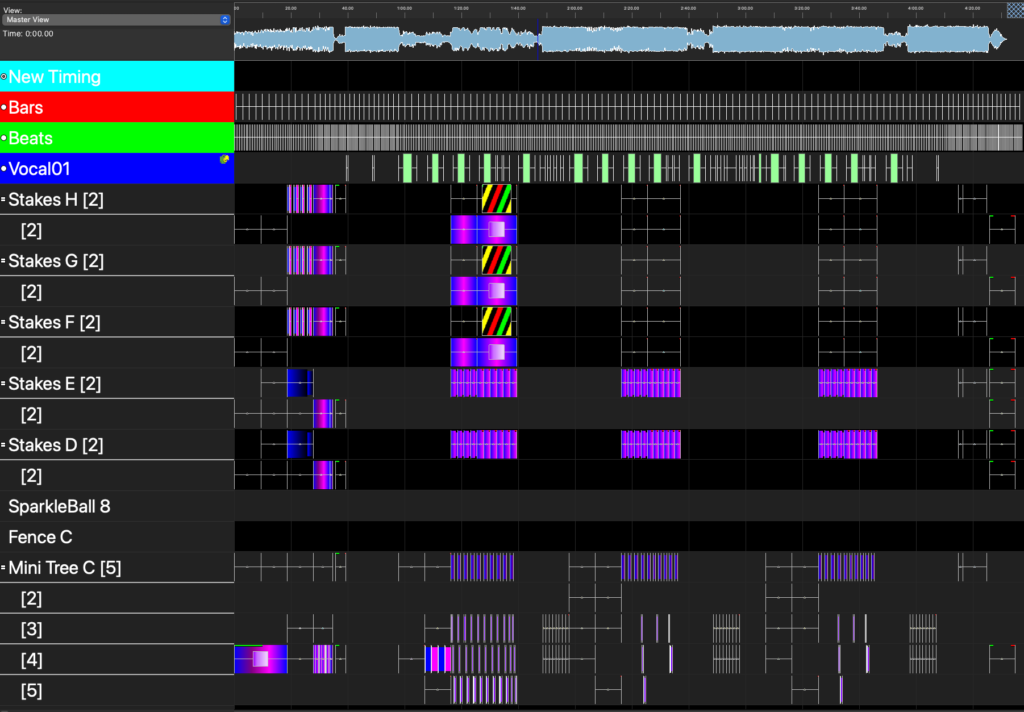
Snow Flake
A snow flake shaped (six-sided) construction, usually of coro-plast but sometimes made of wood, metal, or other plastics, which holds pixels in a pattern, able to display colors and light patterns.

Photo Credit: boscoyostudio.com
Smart (Differential) Receiver
These are advanced Differential Receivers (defined earlier) developed by Falcon and Kulp for their own hardware. These can be daisy-chained together using Ethernet cable to expand the footprint of your show long distances. Depending on the controller and version of the smart receiver- three or more of them can be chained together to support four or more pixel channels over long distances. While “dumb” receivers are fairly universal, most smart receivers are manufacturer and controller generation specific, using proprietary protocols, and there is no real standard for them (as of 2022).
Both manufacturers are expanding the diferential capabilities of their hardware, so this information may be outdated. It’s important to just note that these allow you to expand your show longer distances like a regular Differential Receiver, but they have some advanced functionality.

Sparkle Ball, Sparkleball
This is an “old school” holiday decoration made by fastening clear plastic cups together into a ball and inserting mini Christmas lights into them. The design can be adapted for pixels to provide an organic display of colors and patterns, sometimes liquid or crystal-like.
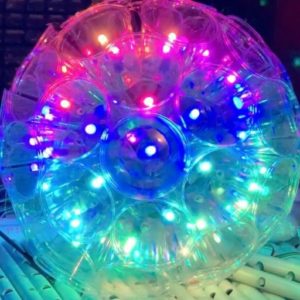
Image Credit: https://lunardenlights.com
Sparkledrop, Gumdrop
Sparkledrops are a variation of the Sparkleball, and Gumdrop is a term for a yard prop resembling a gumdrop. Often gumdrops are either built from scratch or use “dumb” gumdrop lights available from home centers or Amazon and retrofit them with pixels or LED floods. These can either be lit floodlight style with single colors, or can have multiple pixels with a spiral-tree or sphere effected added to them, depending on how they are made and wired up.
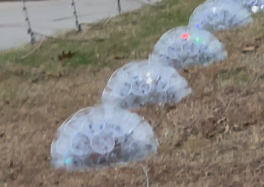
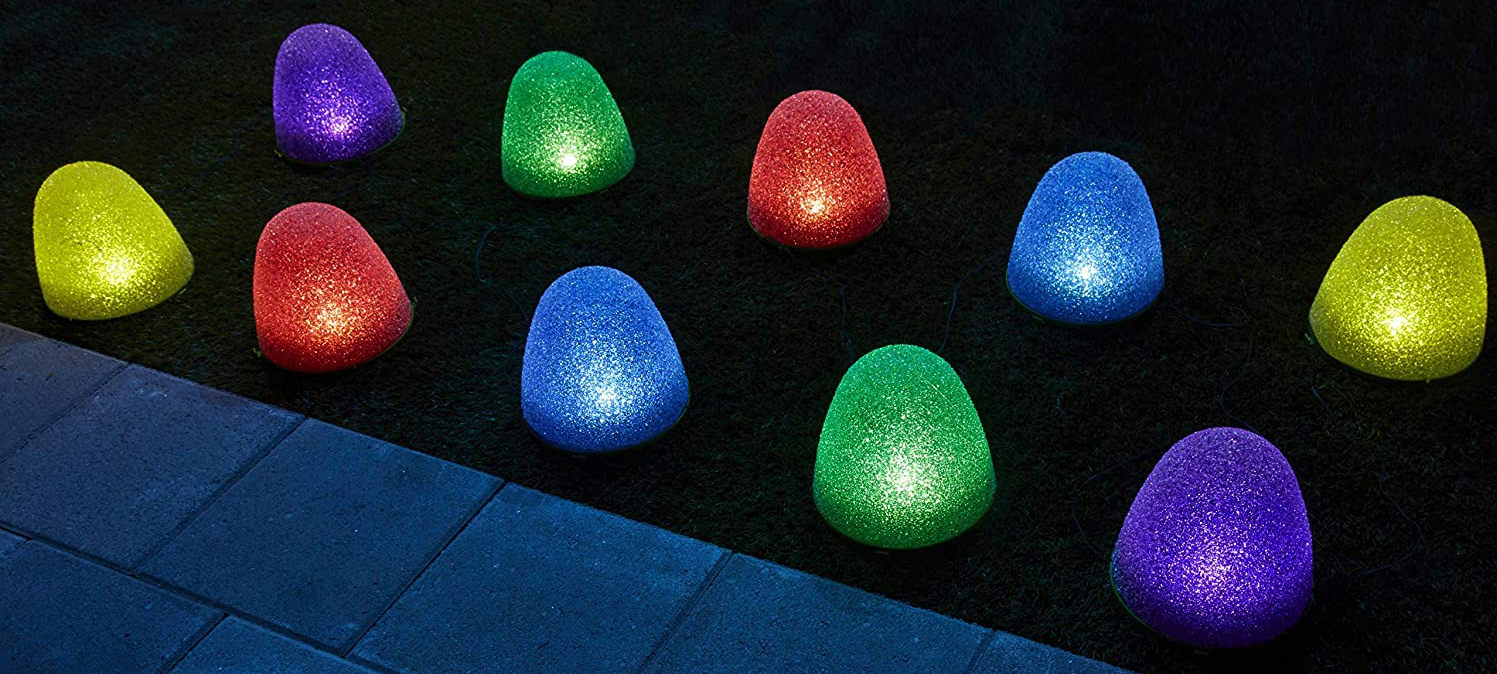
(Image from amazon.com)
Sphere
A 3D ball-like construction surrounded by pixels in a set pattern. These can generally display complex 3D light patterns at 360 degrees. Some have high pixel density and can provide a matrix-like display.

Photo Credit: boscoyostudio.com
Spinner
A round construction, usually of coro-plast but sometimes made of wood, metal, or other plastics. These are generally used to display spinning effects, but high density versions can have matrix-like properties that can display a large variety of complex light patterns.
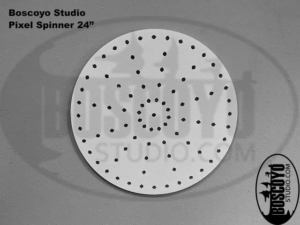
Image Credit: https://boscoyostudio.com
Square Pixel
These are a popular pixel format often used for props and outlines where their format may be easier to mount because they have a “flat” bottom. The LED “pixel” itself is the same 12mm diameter, but the circuit board(s) are in a flat block underneath it and the wires come more out of the side, instead of back like a bullet pixel. They can result in a thinner-flatter prop and in some cases are easier to work with than bullet pixels.
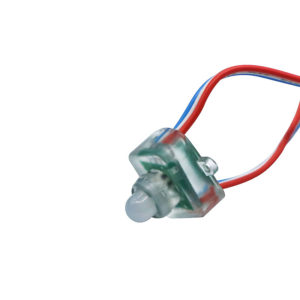
Star
A classic star shaped construction. Some are similar to Snow Flakes and Wreathes with basic pixel patterns capable of displaying colors and simple patterns. Others are higher density can display complex patterns.

Image Credit: https://boscoyostudio.com
Starburst, Firework
A Starburst or Firework consists of either a 3D-Printed hub, or a fish attractant sphere like the one linked below, with multiple pixel sticks/poles emanating from it. It can be used as a tree topper, large pixel pole topper, roof effect, or ground effect. Can produce a lot of really cool burst and spinner effects.
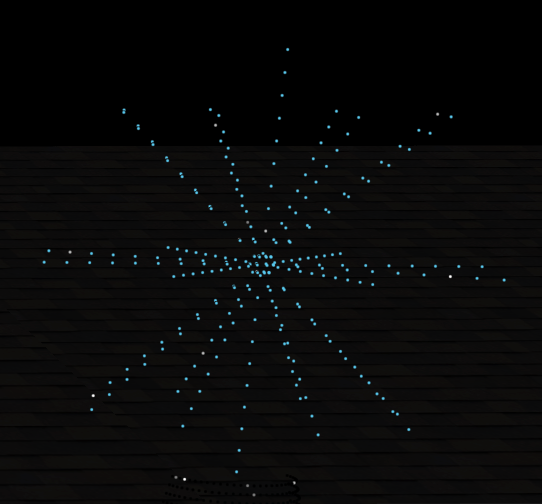
 Strip
Strip
Refers to LED strips. These are the flexible ribbons of LEDs most commonly used as accent and cabinet lighting inside the home. There are WS2811 compatible outdoor-rated versions that can be used for house outlines, arches, pixel trees, etc. These can usually be driven by the same controllers as pixels. Sometimes the LEDs cannot be individually addressed, but can be addressed in groups of three, still making them usable for many decorating applications. These are not in-favor as they have a very high failure rate compared to pixels. They are also almost impossible to repair and difficult to replace once installed. A popular phrase used in this hobby is “Friends don’t let friends buy strip!” They do have their place though and many do use them successfully in their displays.
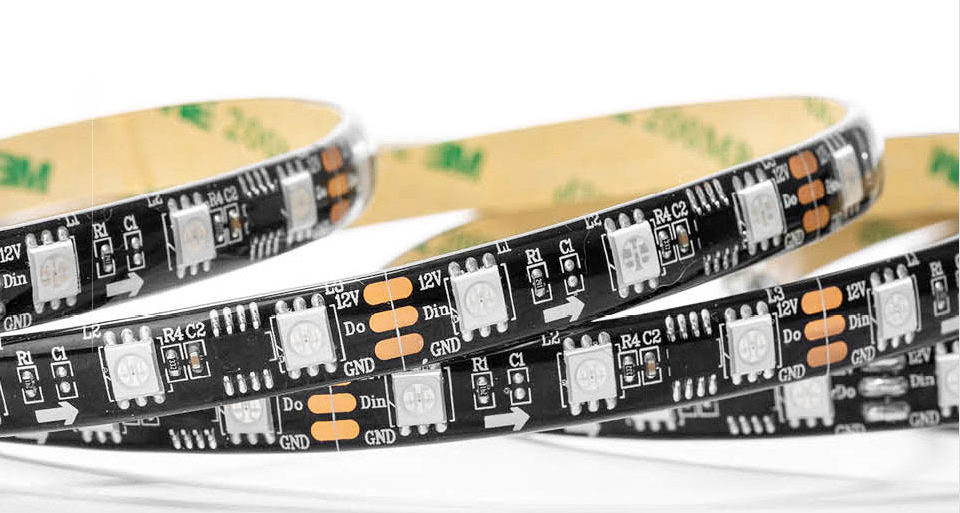
Stand-Alone
This just refers to a single controller that runs a whole light show by itself. It does not need to “talk” to any other controllers. It is its own Show Runner and it controls all of the shows pixels itself. This is commonplace for smaller shows, usually under a few thousand pixels.
Virtual Matrix
A virtual matrix is a video representation of a matrix created on an HDTV or a projector incorporated into a display. Very large, very high-density matrixes can be created this way, and are often preferable to actual pixel matrixes which can become unruly at larger sizes. Another advantage is the HDTV or projector can be used to present video content as an alternative to matrix content when appropriate. For example- a virtual matrix of 160 rows by 320 columns can be easily created. A similar pixel matrix would require 51,200 pixels, which would be very expensive and heavy to construct, requiring multiple controllers and power supplies.
WLED
WLED is pixel controller firmware that can be loaded on an NodeMCU (see “ESP” definition). It was originally designed as a stand-alone controller to display from a pretty extensive menu of pixel patterns. It can also be controlled by Alexa and other home automation systems. It has more-recently been adapted as an e1.31/DDP controller, which can accept data from a show-runner/scheduler like any other controller. Like the ESPixelStick- it can generally only support a single string of pixels. It has seen recent favor over ESPixelStick because it supports ESP-32 devices, which have better WIFI radios than those using older ESP-12 (ESP8266) chips. In my experience it has a lot more overhead than ESPixelStick and hasn’t been as reliable as an e1.31/DDP controller. ESPixelStick is being ported to ESP-32, and should be a better option eventually. WLED is a great option for off-season displays where just color changes or patterns are desirable, such as for flood and accent lights, and those with “permanent” pixel installations.
More recently (2022) the extensive WLED pattern library has been added to FPP, which can be used for display testing or static lights-only displays.
Wreath
A round donut-shaped construction, usually of coro-plast but sometimes made of wood, metal or other plastics, which holds pixels in a pattern able to display colors and light patterns. Generally a wreath is used for “spinner” effects, although higher density ones can produce matrix effects.

Image Credit: https://boscoyostudio.com
WS2811
This is a data signaling protocol used by most pixels in this hobby. There are some similar and compatible protocols supported by some controllers, but this is what you will see the most of. WS2811 actually refers to the chip that drives the pixels. In a string of WS2811 pixels- a data stream containing color intensity data is sent that tells every pixel in a string what colors to display, in order. In simplest terms- each pixel displays the first color data it “sees”, and then re-transmits the remaining data to the next pixel. This happens very quickly, but there are timing limits which is why each channel on a controller only supports a limited number of pixels, based on how often the pixels need to be updated. If a string is too long- it simply becomes impossible to feed it all of the data it needs within the time period needed to synchronize the display.
xLights
The most commonly-used software to “sequence” a light show. Can be used to generate patterns of lights on one, many, or all configured pixel props and installations, and can sequence those patterns to music, displaying patterns, text, and other elements such as “singing” faces that are synchronized to an audio track.
https://xlights.org/
xScheduler
xScheduler is a show-runner/player currently only available with the Windows versions of xLights. Mac development and support was abandoned in early 2020. It can be used to run sequences, sending display data out to controllers while providing an audio source for pixel light shows. Because it only runs on Windows computers, and other Windows activity and computer usage can disrupt it, it has fallen out of favor and has largely been replaced by FPP. It is still supported by the xLights developers, and many still use it, usually on dedicated “show” computers that aren’t used for anything else. It is necessary to disable all other applications, notifications, system sounds, and things like Windows Update, as these can all interfere with a show.
NOTE: In many cases- product images, logos, and names of specific vendors have been used for illustrative purposes. Their use does not imply any endorsement or recommendation.
Please be sure to check out our Pixel Resources page for more information and links!
Please request corrections and additions through our social media accounts or email us at:![]()
